7 Proven Resource Management Techniques to Keep Projects on Track
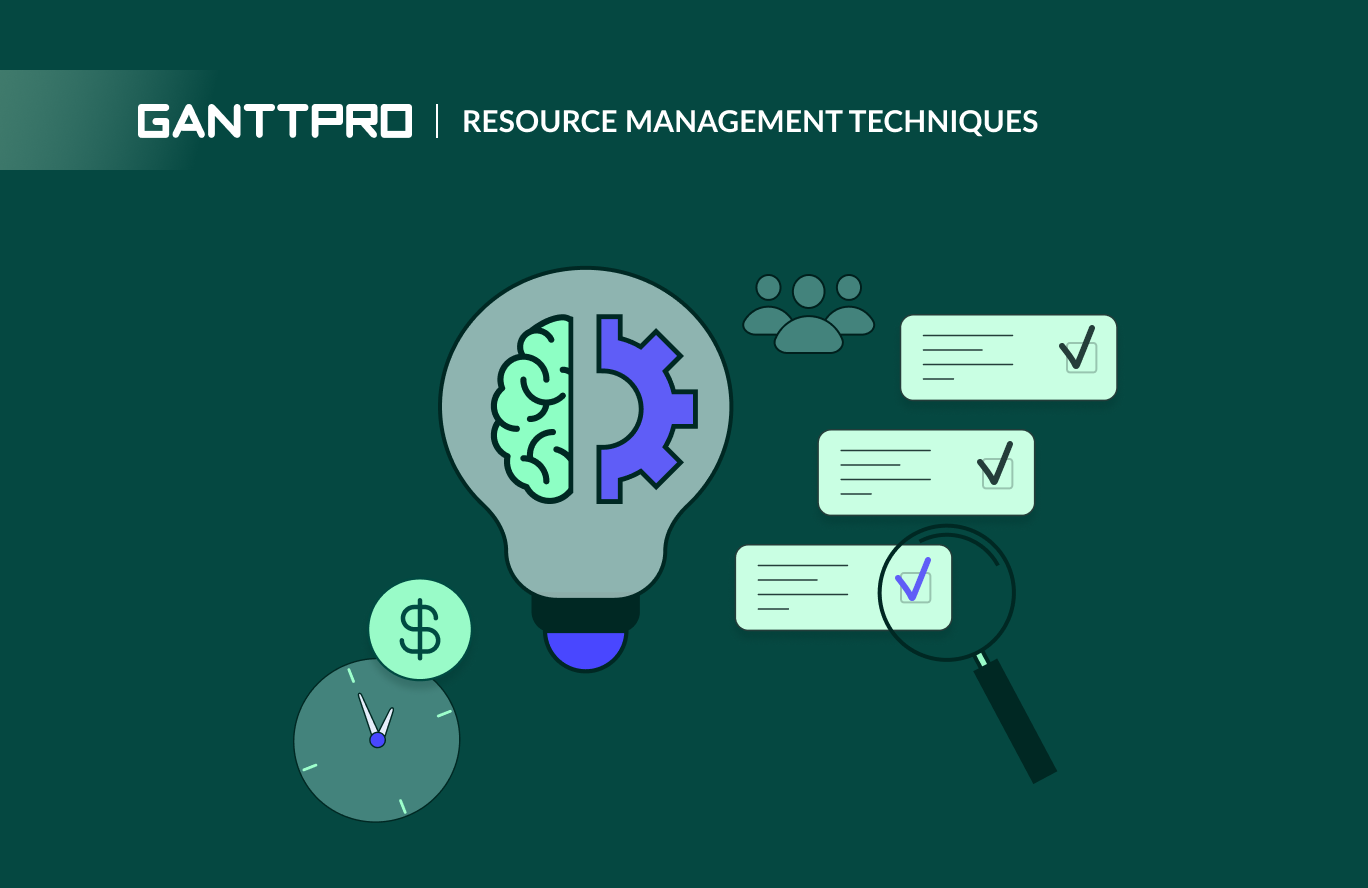
Audio version:
Efficient resource management goes beyond simple task and asset distribution. It involves a deep understanding of team capabilities, project details, dependencies, and a broader impact on the entire business. It’s like painting a picture: choose the right colors and brushes, and the whole plot will come together.
Teams that apply robust resource management techniques transform their work assets into significant strengths. These strategies enhance resource scheduling and work organization, boosting overall productivity.
To keep up with the pace, it’s important to learn these powerful techniques and enable them in business.
This article will enhance your expertise on this subject.
Contents:
- What are resource management techniques?
- Why are resource management techniques important?
- 7 resource management techniques with examples.
What are resource management techniques?
Resource management techniques are special strategies used to allocate, schedule, and utilize project resources properly. Managers apply them to enhance productivity and achieve business goals.
These techniques aren’t one-size-fits-all. Instead, they offer certain frameworks and rules that you can tailor and apply as needed to fit your project requirements and nuances.
Some of these methods are better for small projects, while others look more appropriate for larger and complex endeavors. Some of them don’t require special tools, but the majority can be professionally visualized with online PM tools or specialized platforms for effective resource management.
By the way, there is an engaging statistic within the State of Resource Management report (2022). It demonstrates the percentage of satisfied users who use dedicated resource management software, project portfolio management tools, or regular spreadsheets to work with resources.
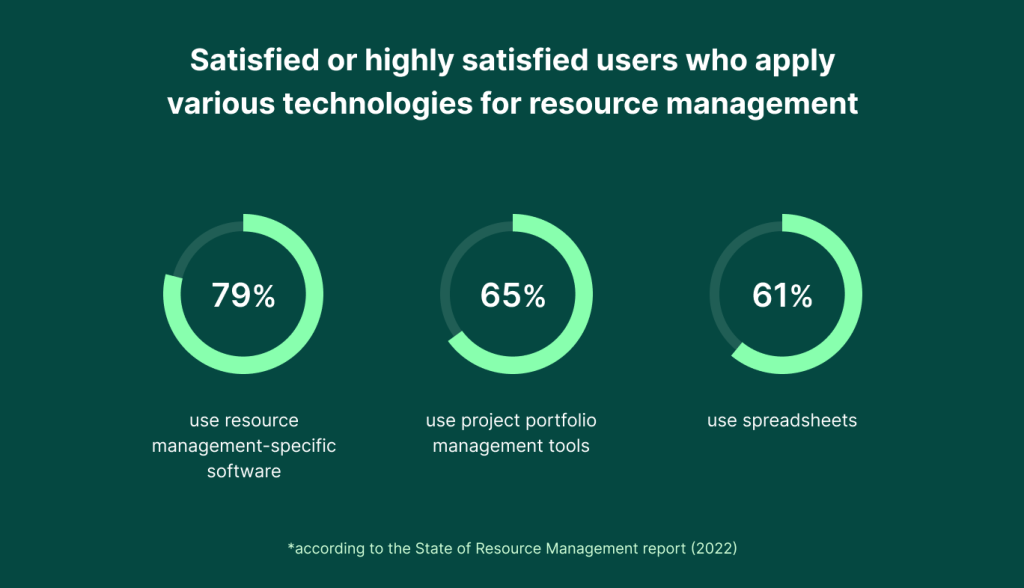
As you can see, resource management-specific platforms have high weight and popularity. The combination of these tools and reliable techniques is of particular importance to any project manager.
Let’s learn more about this importance.
Why are resource management techniques important?
By optimizing the use of available resources, companies can enhance productivity, reduce costs, and improve overall performance. Effective resource management also ensures that the right work assets are available at the right time. It prevents bottlenecks and facilitates smoother operational flows.
To learn more about the importance of resource management techniques, consider the insights listed below.
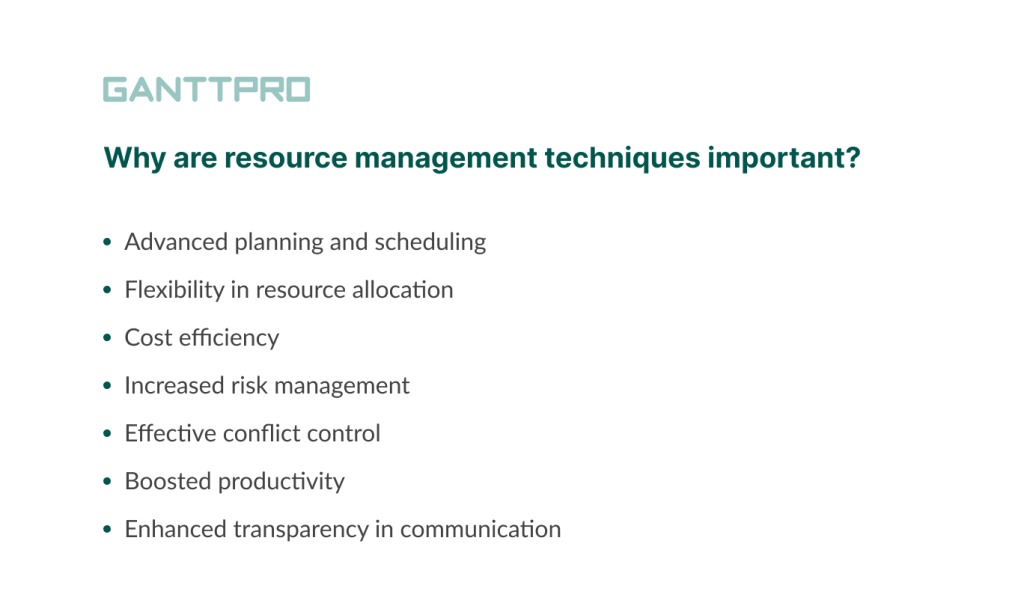
- Advanced planning and scheduling. Some resource management techniques help project teams forecast asset needs and plan their use. This foresight can prevent overstaffing or understaffing scenarios and ensure timely project completions.
- Flexibility in resource allocation. With resource management techniques, businesses can quickly adapt to changes in demand or circumstances by reallocating their assets efficiently. This flexibility can be critical in responding to unexpected challenges, resource constraints, or market changes.
- Cost efficiency. By optimizing resource utilization, project managers can minimize waste and reduce costs. Proper resource control helps identify surpluses and deficiencies. It allows for corrective actions that will align spending with actual needs improving the overall financial health of a company.
- Increased risk management. By having a clear understanding of how to allocate resources, PMs can identify potential risks more effectively and implement mitigation strategies promptly. This proactive approach reduces downtime and ensures that all operational goals are met without significant delays.
- Effective conflict control. A well-structured resource calendar helps minimize resource clashes between workers or departments vying for the same resources. Implementing clear asset management techniques will reduce dispute likelihood, fostering a more collaborative environment.
- Boosted productivity. Proper resource allocation in project management ensures that all work assets are utilized to their maximum potential. It typically includes human resources, where task allocation is based on skill sets and workload capacities.
- Enhanced transparency in communication. These techniques enhance transparency among all stakeholders, including team members, clients, and sponsors. This openness builds trust and facilitates smoother communication, streamlining project management.
In addition to all mentioned above, resource management techniques help young project teams improve their skills and gain experience. If managers master most of these techniques, they can be considered professionals.
This is rather important, as according to the Wellington study, only 47% of companies surveyed said that their projects were managed by professional project managers.
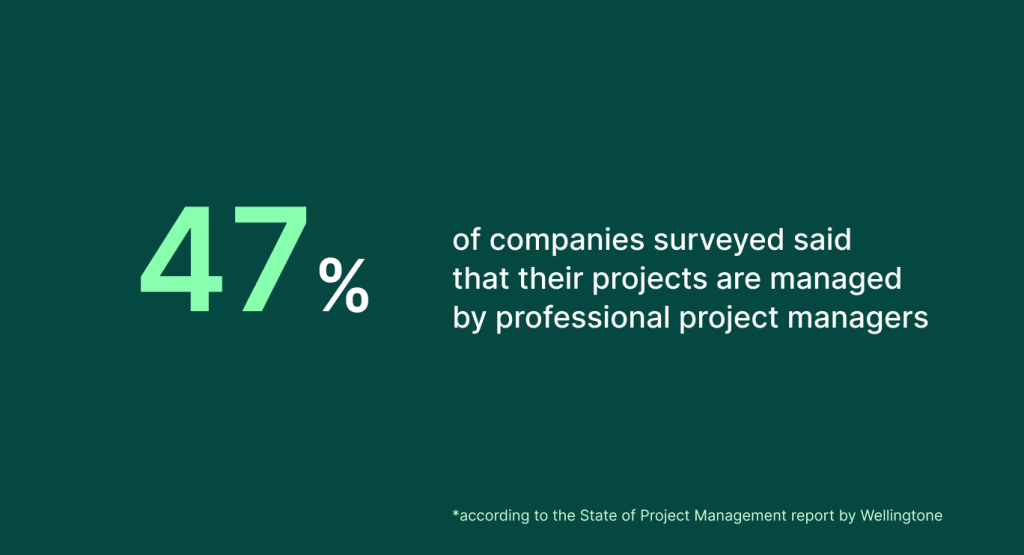
Of course, this percentage could (and should) be higher.
Overall, project managers should learn and apply these types of techniques, use available resource allocation methods, and implement resource management best practices to succeed in their work.
To make a long story short, let’s now explore top techniques and try to get the most out of them for business advancement.
7 proven resource management techniques to ensure work on the right things at the right time
Managers may already have experience with some resource management techniques without realizing it. It may happen because these strategies share the same goal of providing clear visibility and control over work assets and projects.
Let’s explore each technique with its fundamental principles and how they can be applied in our daily management activities.
- Resource planning.
- Resource allocation.
- Resource scheduling.
- Resource utilization.
- Resource forecasting.
- Resource leveling.
- Resource smoothing.
1. Resource planning
Resource planning is a basic technique you may face when working with project assets. It ensures that a project is provided with sufficient human resources with corresponding skills, knowledge, and experience as well as other required assets (technical, financial, etc.). Consequently, this technique can help to compensate for a lack of resources, no matter if you plan for a single activity or deal with resource planning for multiple projects.
In essence, resource planning helps you highlight the when, how, and who of your project. Although this process may include counting equipment, vehicles, meeting rooms, and more, the most important resources are always employees who will move projects forward.
While planning your resources, you should consider possible vacation, sick days, and contingencies (for example, a change in project scope), which can cause shortages and impact your workflow organization.
To apply this technique, you need to break down your project into tasks or steps (for example, using a handy work breakdown structure) and visualize all resources. To do it correctly, you’ll definitely need one of the powerful resource management tools.
A brilliant decision is to apply a Gantt chart. This diagram serves as a trustworthy visualization system that lets teams plan, organize, and control work assets with ease.
One of the best software solutions with such a diagram is GanttPRO.
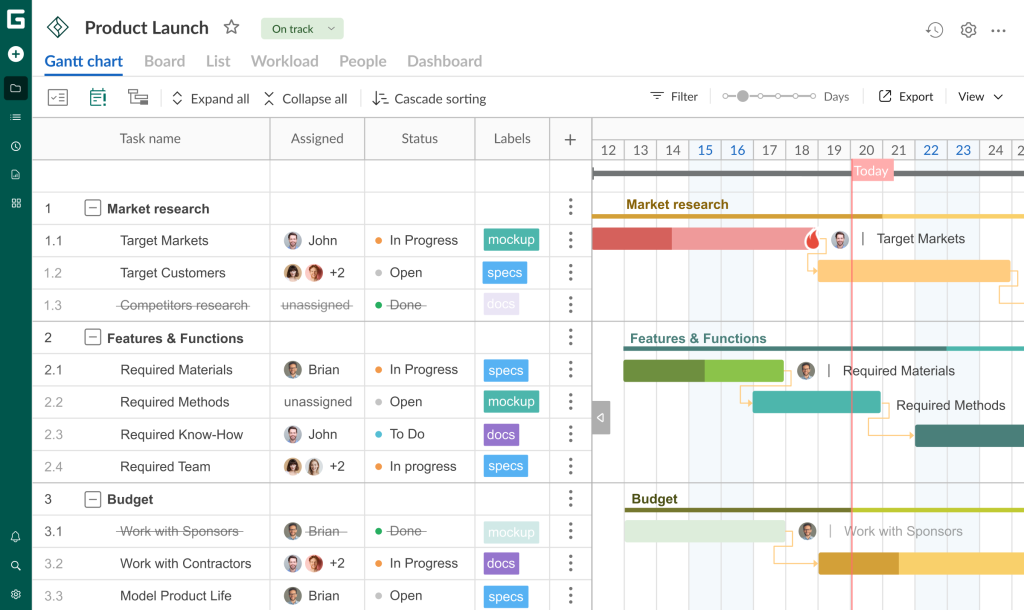
The software offers an online Gantt chart that assists in facilitating successful outcomes in diverse industries such as software development, construction, events, manufacturing, and more.
It helps professionals enhance project management, task planning, deadline control, event tracking, team collaboration, and advanced resource organization.
Project teams choose GanttPRO for its effective project planning and asset organization, which makes it a trusted resource management software.
Remember that resource planning is not a one-off work process. Regular reviews and adjustments to your resource plans are crucial as projects evolve.
One of GanttPRO users, George Rossle, a production manager at A+ Construction Pro, shares his thoughts about the power and role of the tool:
For us, GanttPRO is a basic tool for planning and management. We use the software for deadline management and time tracking, file sharing, and smart scheduling.
The example of the resource planning technique
Imagine you’re about to roll out a new marketing software program.
Resource planning will involve listing down all tasks and subtasks including initial meetings, work shifts drafting, software testing, marketing budgeting, user training, etc. Then you will match these tasks with your available resources.
As a result, you’ll have a clear understanding of who is responsible for each activity.
2. Resource allocation
When we talk about resource allocation, we mean the process of finding the right project management resources for the right tasks in a way that supports project goals and objectives. However, it’s not only about matching skills and tasks.
A significant challenge here is the overallocation of resources.
The asset allocation process is inherently flexible. It evolves throughout the project’s lifecycle. Consequently, it’s crucial to maintain adaptability in resource allocation, particularly when coordinating with remote team members.
For example, a new feature during the project course can change its scope and require the involvement of additional designers for just a few days. But if all designers are busy or aren’t available for the hours you need, your project will get into trouble.
The process of resource allocation might seem vague and complicated if we weren’t aware of such smart online solutions as GanttPRO.
The software helps gather and visualize all required resources intelligently.
You need a couple of clicks to invite certain team members, set costs and calendars for them, and specify their project roles. Additionally, you can create virtual resources including people, materials, tools, facilities, etc.
Here’s what Adam Hirsk, the head of product and R&D at Pacvac, a manufacturer of backpack vacuum cleaners (Australia) thinks about it:
I like using virtual resources. I set them up as departments to give a broader view without specific assignees – this can come later. The virtual resources allow another good level of customization and are useful for filtering your views of a Gantt chart.
Resource allocation in GanttPRO is a piece of cake. The software assigns resources and specifies workers, deadlines, and dependencies with ease. It’s possible to allocate one resource or several assets to each task.
This big picture will allow you to provide all stakeholders with accurate estimates of when and how things will be done.
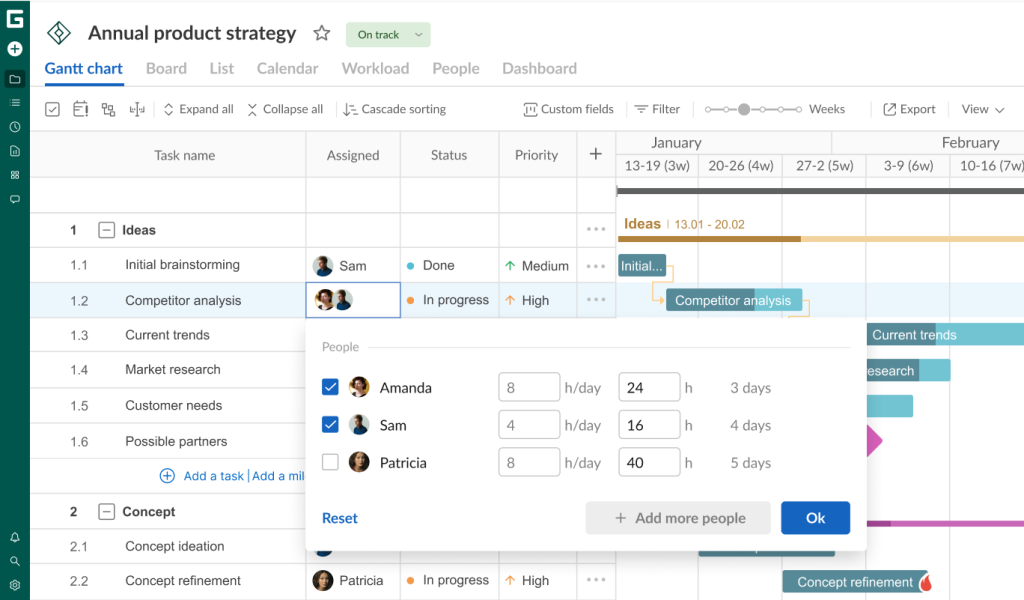
The example of the resource allocation technique
There are many examples of resource allocation techniques project management specialists apply around.
Let’s consider a rebranding campaign for a digital marketing agency.
After thorough planning, you’ll need a graphic designer, a motion designer, a social media specialist, and a content manager. Allocating resources will mean assigning certain tasks to each of these specialists.
The graphic designer can be responsible for creating social media images and blog graphics. At the same time, the content manager may work with blog articles and comments on social media.
3. Resource scheduling
With the resource scheduling technique, managers can assign employees exactly when they need them, so their projects are covered from start to finish.
Efficient coordination across diverse project teams is crucial to avoid delays and ensure optimal asset utilization. When scheduling, it’s important to align tasks sequentially to prevent a team from being idle, awaiting others to complete their work.
Traditional tools like spreadsheets have evident drawbacks for this purpose. They are labor-intensive and susceptible to errors. Additionally, spreadsheets don’t offer detailed visual task tracking and complete visibility into team workloads.
In turn, powerful resource scheduling tools like GanttPRO provide a clear visual representation of assignments across teams.

Online resource management tool
Manage tasks and projects, control deadlines, and apply reliable resource management techniques.
Sign up for freeAn online Gantt chart with resource allocation allows for detailed filtering of employees by department, skills, location, and more, ensuring that the right tasks are assigned to the right people at the right time.
GanttPRO also offers the option to configure personal calendars. With their help, you can schedule and track daily activities or working hours of your resources seamlessly.
It’s easy to plan and manage working shifts, seasonal holidays, vacations, days off, and other dates here.
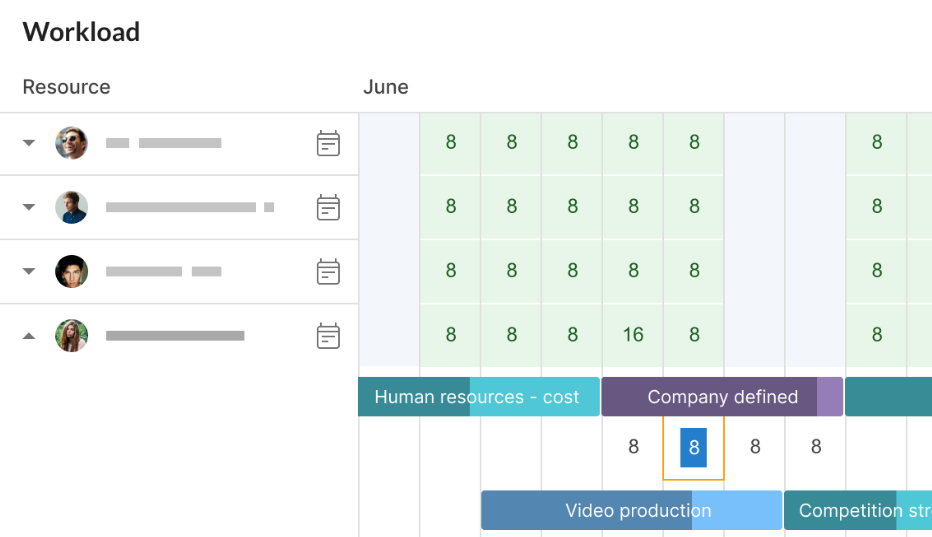
The example of the resource scheduling technique
Imagine you need to develop a plan for a scientific conference at a college.
Resource scheduling in this context may include ensuring that humanities students complete their presentations before economics students begin their conference work.
Thus, young economics specialists will not wait for free resources (a conference room, hardware, a projector, volunteers), and humanities specialists will not rush to make changes at the last minute.
4. Resource utilization
The process of resource utilization assesses the effectiveness of how project assets are deployed in business. Tracking metrics such as billable versus non-billable hours or resource availability ratios enable you to measure how well resources are being used.
Identifying underutilized assets provides the opportunity to adjust and optimize performance to maximize its potential.
In simple words, with this technique and the platform as GanttPRO, you can measure the delivered work to define whether your resources are under or overutilized.
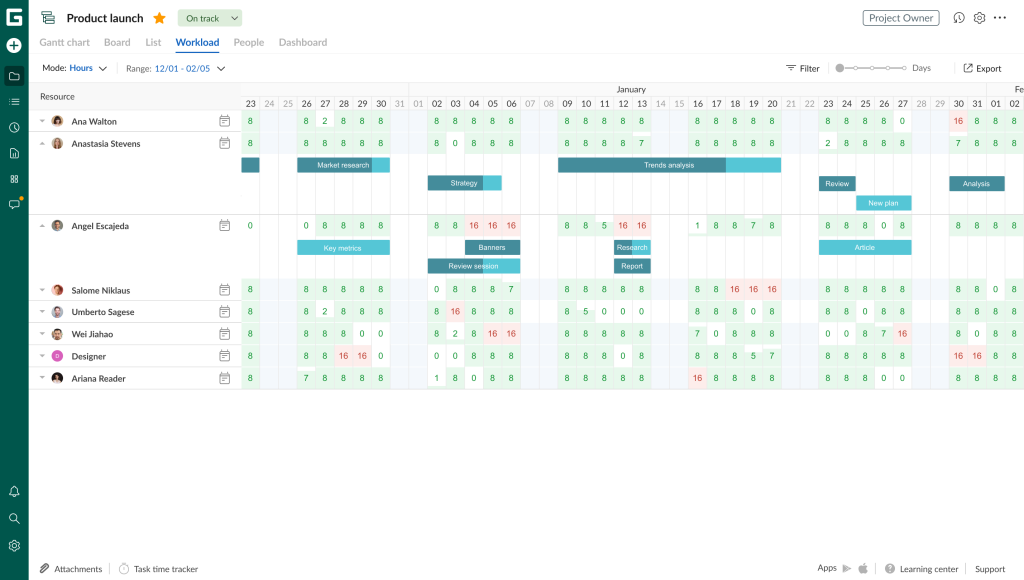
The example of the resource utilization technique
Now your possible project is recording online educational classes for students.
After launching the first part of the program, you found that while most team members were actively engaged, your videographer had some downtime.
To maximize resource utilization, you consider leveraging this opportunity to produce promotional videos for the course.
This approach not only optimizes your team’s productivity but also enhances the value of your investments in personnel.
5. Resource forecasting
A standard resource management plan usually begins with resource forecasting that anticipates team composition and skill sets required for upcoming projects. This proactive step is crucial in verifying that you have the necessary assets, or if external hiring is needed.
Resource forecasting addresses potential issues with employee underutilization or overbooking. Early in the planning stage, it’s vital to assess team availability against existing commitments and planned absences. It’ll help avoid disruption when launching new projects.
When everyone in a team tries to do more and works longer hours, they will be stressed out and overworked. Relying on freelancers isn’t a fail-safe: availability and training may not meet immediate needs or quality standards.
All this means that ineffectual forecasting is a real risk for employee dissatisfaction, client discontent, and project delays. By applying the related technique, you’ll be able to predict and mitigate these challenges.
The example of the resource forecasting technique
Let’s say you’re going to redesign a fitness app. The works are planned to last 3 months.
Before diving into this project’s details, you want to estimate the type and quantity of resources you’ll need. It may involve predicting the available budget, hardware, the number of designers for visuals, backend developers, QA specialists, content writers, and external sports experts. Some of them can be in-office workers and some may perform as freelancers.
6. Resource leveling
Many projects require changes, no matter if they are planned or unplanned. Resource leveling techniques in project management optimize timelines and deadlines, ensuring they align with available resources.
This approach involves redistributing resources across projects for optimal results, as determined by project managers. Essentially, it ensures work assets meet project needs effectively.
The technique is feasible with a flexible project schedule. If not, alternative resources must be sourced to meet project demands, preventing team member overload and reducing burnout risks. It not only enhances productivity but also fosters a more balanced work environment.
This thought is supported by Dr. Mike Clayton, the founder of Onlinepmcourses.com. He evaluates the role of this method as follows:
Resource leveling is more tractable when you’ve got a smaller number of resources and therefore you can readily do it by hand. We use resource leveling to handle resource constraints on our projects when our people would otherwise be overallocated and required to work too many hours in a day.
With tools like GanttPRO, which features an intuitive Gantt chart and drag-and-drop capabilities, this leveling becomes a swift and straightforward process that significantly simplifies resource management.
The example of the resource leveling technique
During the construction of a residential complex, you notice that your сhief engineer isn’t available to complete a task you thought he would be available for.
In this case, resource leveling will mean changing the start and end dates of that task to days when the engineer is available.
The implementation of this technique is possible with the help of a visually appealing Gantt chart.
7. Resource smoothing
When your project timeline isn’t flexible, the resource smoothing technique comes to the rescue because this is the process of adjusting resource usage.
Unlike with resource leveling, you cannot simply adjust the due dates of tasks or deliverables. Instead, you may need to enhance your resources to meet demanding deadlines.
The primary advantage of this approach is a project schedule that is both flexible and adaptable. It enables better responses to changes or unexpected events.
You’ll still meet project deadlines, but a flexible schedule will allow you to adjust who does what and when to accommodate changes in staffing or resource availability.
In general, resource smoothing is often used intuitively and sometimes without even realizing it. For example, when experts are brought in to accelerate project tasks efficiently.
Let’s see what David McLachlan, an Agile coach and project manager, thinks about this technique:
Resource smoothing adjusts the activities of a schedule model within their free and total float. So, because of that, a critical path is not changed because we’re just using up the available wiggle room in our schedule.
The example of the resource smoothing technique
Let’s say, your team redesigns an e-commerce website having inflexible deadlines.
Suddenly, you get an extra budget to bring in an additional developer or perhaps outsource the work to a more experienced or qualified developer who can work faster.
This way you smooth out resources to optimize performance.
Well, it seems that’s all we wanted to tell you about the basic resource management techniques. The only thing that remains is to conclude.
Practice resource management techniques to get a healthy workflow and a happy team
If you know how to apply resource organization strategies properly, you’ll achieve work harmony and project success. With their help, your team will keep projects on track and get the work-life balance they crave.
After all studied here, you can be sure that in case you have a resource conflict or some other asset challenges, you can easily apply the following resource management techniques:
- Resource planning.
- Resource allocation.
- Resource scheduling.
- Resource utilization.
- Resource forecasting.
- Resource leveling.
- Resource smoothing.
These techniques in conjunction with a trustworthy resource planning tool like GanttPRO will let you fix issues and manage your team’s workload efficiently. As a result, you’ll get well-organized tasks that will be efficiently distributed among all your projects.
Read also
Join 1M+ project managers!
Create Gantt charts in minutes with GanttPRO and reduce time spent on managing tasks by 40%
Try for freeNo credit cards required. No obligation.


